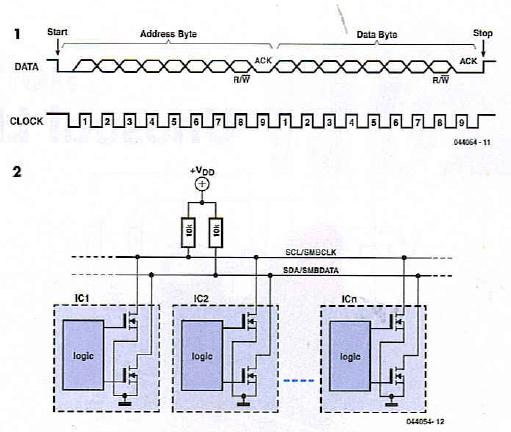

Project Solutions
I²C and SMBus
Published:2011/8/11 1:36:00 Author:Amy From:SeekIC
Paul Goossens
The l2C-bus has been dealt with before in Elektor Electronics. Most readers will know that this bus requires only two signals to communicate between, for example, a controller and one or more ICs in a circuit. We may also assume that it is well known that this bus was developed by Philips and is used mainly in televisions, video recorders, tuners, etc.
Unfortunately, the l2C-bus lacks a number of features that manufacturers of computer motherboards require. They therefore developed their own bus, which has been derived from the l2C-bus. This bus goes by the name SMBus (System Management Bus). The main task for the protocol is to provide communications between the processor and various temperature sensors, battery management/charging-chips and even memory modules, etc. in a PC. Because the SMBus has been derived from the l2C-bus, there are obviously a number of similarities. It is in many cases even possible to let components with an l2C-bus communicate with those with an SMBus and vice versa.
The similarities
Both bus protocols make use of the same start and stop mechanism. A start-condition can be recognized by the falling edge on the data line while the clock line remains high. With a stop-condition, a rising edge appears on the data line while the clock line is high. These two conditions are the only situations where the data line may change level when the clock line is high. This can be seen in Figure 1. 
Following the start condition there is the 7-bit address that has to be unique for each device connected to the bus. Another similarity is that the bus has a single pull-up resistor for each signal and the connected chips drive these signal lines with an open-source output, as can be seen in Figure 2. This forms a so-called wired-OR configuration. As soon as one of the chips pulls a signal line to ground, the signal will have a low level, irrespective of what the other chips try to do.
The differences
Naturally there are also a number of differences between the two protocols. We start with the clock speed. With l2C-bus this can vary from 0 to 100 kHz in NORMAL mode and up to 400 kHz in FAST mode. With the SMBus, the clock speed has to be between 10 kHz and 100 kHz. The minimum speed is the result of an additional provision of the SMBus. If the clock line is low for more than 35 ms a time-out situation occurs. All chips on the bus have to detect this time-out and ignore all communications until a valid start-condition occurs. This prevents one chip from disabling the entire communication of the bus.
Another difference is the specified levels for logic high and logic low. In the l2C-specifications a low level is defined as 1.5 V, while with the SMBus a level less than 0.8 V is required. The high-level is different as well: with l2C this has to be a minimum of 3 V, while with the SMBus a level of 2.1V or higher is considered a high level.
This difference in the required voltage levels would indicate that both protocols cannot be used with each other. In practice this is not so much of a problem, since most chips will generate signals that range from about zero to nearly the power supply voltage.
The outputs of an SMBus IC are specified to be able to sink at least 100 uA, while l2C requires a minimum sink current of 3 mA. All this is related to the fact that the SMBus is also used in laptops and therefore have to be a little thrifty with power consumption. This means a higher pull-up resistor is required. A value of 10 kf2 is usually a good starting value so that both SMBus-ICs and l2GICs can communicate together on the same bus.
There are also a number of subtle differences, such as maximum bus capacitance, rise- and fall-times, etc, but nothing that will prevent you from connecting an l2C chip to the SMBus or the other way around.
Reprinted Url Of This Article: http://www.seekic.com/blog/project_solutions/2011/08/11/Isup2;C_and_SMBus.html
Print this Page | Comments | Reading(448)
Article Categories
New published articles
· Imagination works with TSMC to develop FinFET process
Author:Ecco Reading(33516)
· XMOS pushes event-driven MCUs with lower price
Author:Ecco Reading(3534)
· Intel brings upgraded 32-nm SoC for smartphones
Author:Ecco Reading(3250)
· Micron pushes TLC 128-Gbit NAND flash
Author:Ecco Reading(3816)
· Intel will stop supplying desktop motherboards
Author:Ecco Reading(5341)
· Processor market was expected to regain strength in 2013
Author:Ecco Reading(3318)
· It was reported that TSMC sales fall steeply
Author:Ecco Reading(3474)
· Cisco, NXP work with auto wireless startup
Author:Ecco Reading(3620)
· Micron was impacted by manufacturing glitch
Author:Ecco Reading(4017)
· China can make 22-nm transistor by themselves
Author:Ecco Reading(3819)
· Chip market rebound is coming, according to survey
Author:Ecco Reading(3760)
· Sony, Toshiba will spend more on chips, iSuppli reports
Author:Ecco Reading(3790)
· Qualcomm becomes the 13th company to join NFC Forum board
Author:Ecco Reading(6103)
· TSMC increases building work for FinFET fab
Author:Ecco Reading(3778)
· TI plans to cut 1,700 jobs in OMAP shift
Author:Ecco Reading(4587)